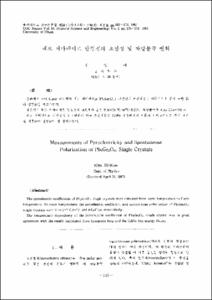신 분말공정에 의한 기능성 다공재 개발 연구
- Alternative Title
- Development of Functional Porous Materials by New Powder Metallurgy Processing
- Abstract
- 고온자전합성법 중 연소파 진행모드를 이용하여 다공질 TiNi 금속간화합물을 제조하였다. 원료분말의 특성, 성형체 밀도 및 점화온도 등을 변소로 햐여 고온자전합성반응에 영향을 미치는 인자를 조사햐였으며, 반응생성물의 미세조직 관찰과 상분석, 기공도 및 기공구조 분석을 행하였다.
다양한 종류의 Ti, Ni 원료분말을 준비하고, 이들 조합을 달리하여 혼합한 분말에 대한 반응 결과, 합성반응을 일으키는 최소점화온도는 280-500℃의 넓은 온도 볌위로 확인되었으며, 최소점화온도가 높은 혼합분말 조합의 경우 시편 내부에 큰 기공이 다수 존재하였었으며, 제2상은 점화온도를 증가시킴에 따라 감소하였다.
한편, (Ti-h + Ni-c)혼합분말을 사용한 경우 가장 안정된 반응거동과 양호한 기공구조를 나타내었으며, 점화온도 증가에 따라 시편내부 기공 크기는 감소하였으나, 기공율은 점화온도에 상관없이 60% 정도로 일정하였다
Porous TiNi intermetallic compound was produced by SHS(Self-Propagating High-Temperature Synthesis). Effects of starting powder characteristic, green density and ignition temperature on synthesis reaction were investigated through microstructural observation, phase analysis, a measurement of porosity and the observation of pore structure for reacted specimens.
Minimum ignition temperature for the propagation of thermal wave front ranged from 280 to 500℃ which varied for the starting powder characteristics. (Ti-h + Ni-c) powder mixtures showed a stable reaction behavior and a good pore structure. From the results showed a stable reaction behavior and a good pore structure. From the results of XRD phase analysis TiNi was confirmed as a major phase. Additionally, Ti₂Ni and TiNi₃ phases were also detected as second phases. The amount of the second phases decreased with increasing ignition temperature which resulted also in a decrease of pore size and uniform distribution of pores.
Porous TiNi intermetallic compound was produced by SHS(Self-Propagating High-Temperature Synthesis). Effects of starting powder characteristic, green density and ignition temperature on synthesis reaction were investigated through microstructural observation, phase analysis, a measurement of porosity and the observation of pore structure for reacted specimens.
Minimum ignition temperature for the propagation of thermal wave front ranged from 280 to 500℃ which varied for the starting powder characteristics. (Ti-h + Ni-c) powder mixtures showed a stable reaction behavior and a good pore structure. From the results showed a stable reaction behavior and a good pore structure. From the results of XRD phase analysis TiNi was confirmed as a major phase. Additionally, Ti₂Ni and TiNi₃ phases were also detected as second phases. The amount of the second phases decreased with increasing ignition temperature which resulted also in a decrease of pore size and uniform distribution of pores.
- Issued Date
- 1999
- Type
- Research Laboratory
- Alternative Author(s)
- Kim, Sung-Ki; Lee, Seung-Hae; Kim, Ji-Soon
- Publisher
- 연구보고서
- Language
- kor
- Rights
- 울산대학교 저작물은 저작권에 의해 보호받습니다.
- Citation Volume
- 1999
- Citation Start Page
- 143
- Citation End Page
- 155
- Appears in Collections:
- Research Laboratory > 연구보고서
- 파일 목록
-
-
Download
 000002024104.pdf
기타 데이터 / 308.39 kB / Adobe PDF
000002024104.pdf
기타 데이터 / 308.39 kB / Adobe PDF
-
Items in Repository are protected by copyright, with all rights reserved, unless otherwise indicated.